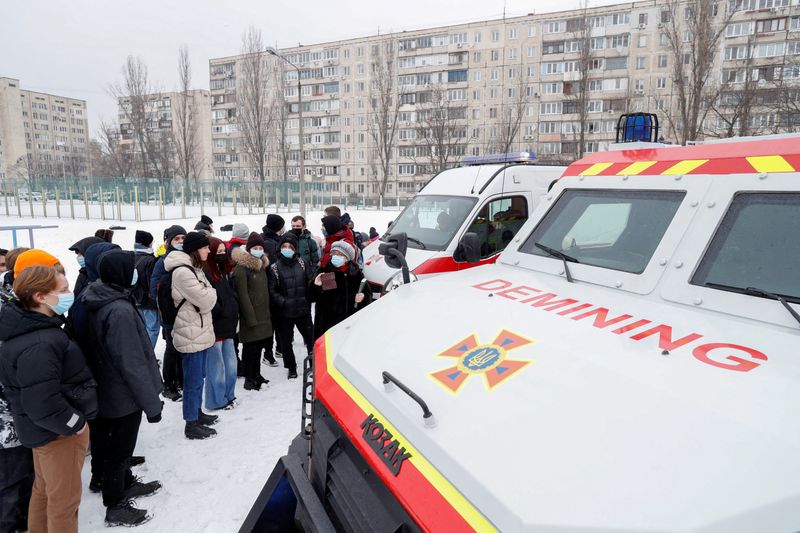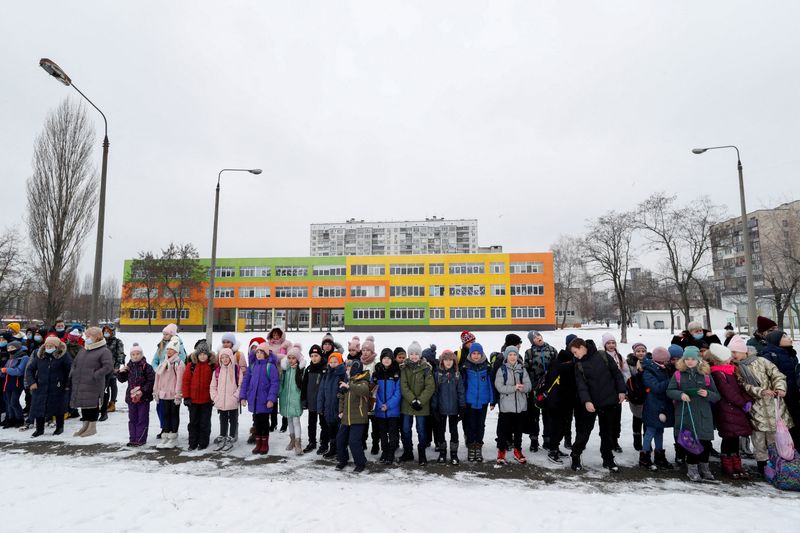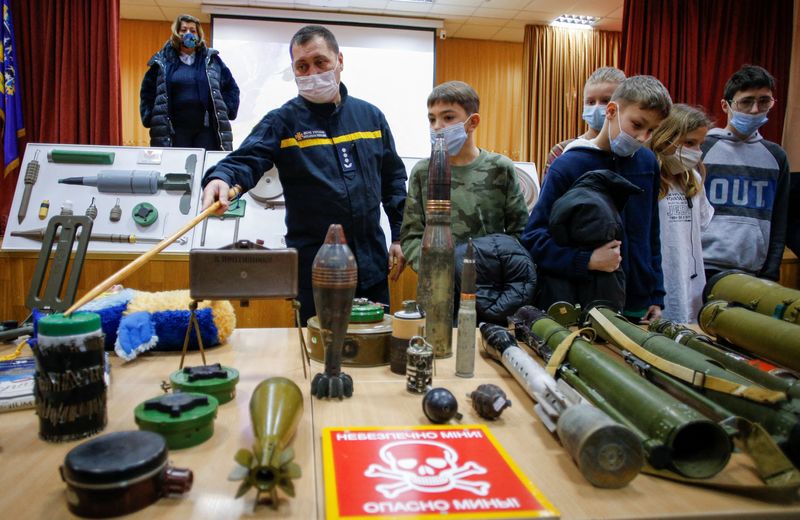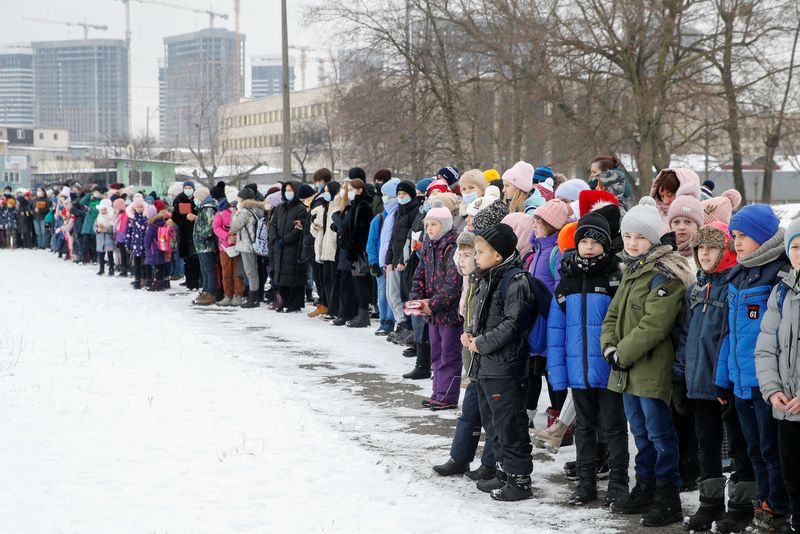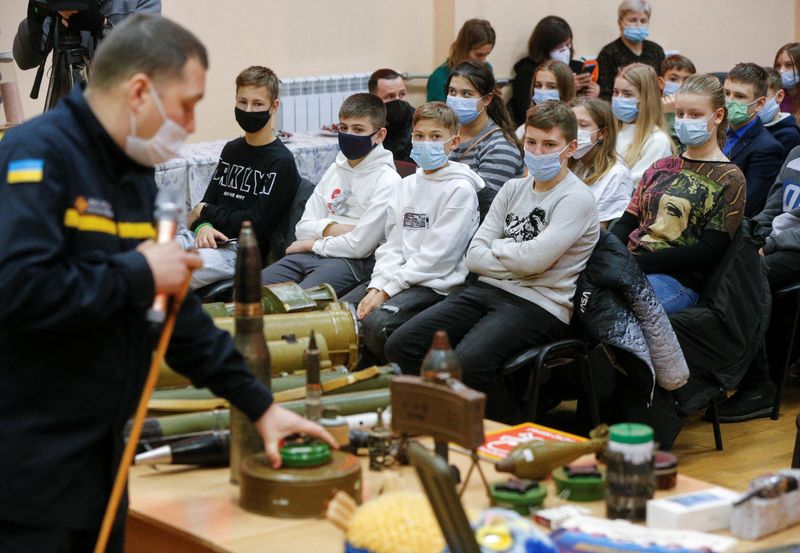KYIV (Reuters) – “How much explosives do you think can fit in this one?” asked a Ukrainian bomb disposal expert, holding up a blue-and-yellow owl mascot in front of astonished pupils attending emergency drills at their school in Kyiv on Thursday.
Law enforcers organised the training after a series of hoax bomb alerts this year forced the evacuation of schools in the capital Kyiv, and other cities, including Kharkiv, Lviv and Zaporizhzhia.
Kyiv blames them on Russia already waging a hybrid war against its former Soviet satellite, while also threatening full-blown invasion by amassing more than 100,000 troops near the Ukrainian border.
“The purpose of Russian special services is obvious – to put additional pressure on Ukraine, sow anxiety and panic among the public,” said Ukraine’s Security Service, adding it had recorded more than 300 bomb threats so far this year, compared to 1,100 for the whole of 2021.
Kremlin spokesman Dmitry Peskov did not respond to a request for comment.
Russian officials have blamed Ukraine for a similar series of bomb hoaxes that have forced Russian schools, shopping centres and kindergartens to evacuate tens of thousands of people. After a pause, the hoax alerts in Russia resumed this month as tensions between Moscow and Kyiv rose.
In 2014, Moscow annexed Crimea from Kyiv and went on to back rebels fighting government troops in eastern Ukraine, an unresolved conflict that has killed 15,000 people to date.
The West has now threatened Russia with severe sanctions if it invades again. NATO – the Western military alliance that goes back to the Cold War and that Ukraine now wants to join – has put its forces on standby.
As the United States leads international talks https://www.reuters.com/world/europe/russia-sees-some-room-dialogue-after-us-security-response-2022-01-27 with Moscow aimed at defusing the latest escalation of East-West tensions, the risk of an open Russian military intervention may not be the most pressing one for Ukraine.
Ukraine’s Center of Defense Strategies think-tank said the main threat was “a hybrid invasion”, including more cyber attacks, disinformation, as well as bomb threats at schools, subway systems, administrative offices and elsewhere.
“It’s always very sensitive when it’s about children. It creates a lot of tension and stress for the parents, for the whole society,” said Alina Frolova, a deputy head of the think-tank and a former deputy defence minister of Ukraine.
“It ties up law enforcement services. It’s easier to make a mistake when the constant tension makes everyone tired. It is to destabilise and demoralise the population.”
NEITHER WAR NOR PEACE
That leaves Ukraine relatively calm – but nervous.
As Ukrainian servicemen in winter camouflage patrol mainly quiet front lines in the east of their country of 41 million people, in many other places life seems to go on as usual.
In Kyiv, holding emergency bomb drills for pupils serves as a stark reminder of the peculiar state Ukraine is in, neither at war nor at peace.
The mascot owl can hold a kilogram of explosives, enough to kill anyone within five metres and wound those up to 15 metres away, the Ukrainian policeman, Oleksandr Shcherbin, told the teenagers.
He showed the class video clips of explosions and scattering shrapnel, artillery and mortar shells, grenades and mines as well as improvised explosive devices resembling a box of chocolates and a mobile phone case.
“Don’t touch it. Don’t touch suspicious objects. Don’t touch objects displayed in an unusual place,” he said.
His colleague summed up the uneasy 45-minute class: “Children, don’t be afraid. Don’t panic. In case of a bomb alarm, follow instructions of your teachers.”
Then a siren went off at the school, on the left bank of the Dnipro river, and pupils and teachers quickly rose to evacuate. More than 360 children, from six to 16, lined up in the snow-covered school yard.
“It’s scary,” said a 13-year-old student who gave her name as Zhenya.
“It makes you realise this can become our everyday reality,” she said, nervously scratching off dark varnish from her nails. “I like going to school for lessons and to meet friends. Not for this.”
(Additional reporting by Natalia Zinets, Andrew Osborn and Margarita Popova; Writing by Gabriela Baczynska; Editing by Nick Macfie)

